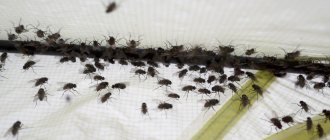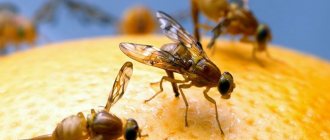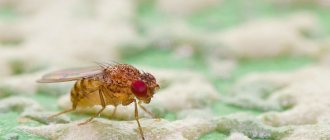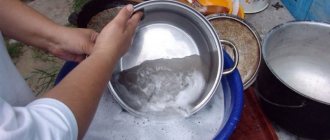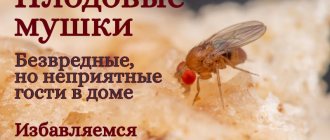Midges are small flying insects that appear in many city apartments with the onset of heat and the season for harvesting vegetables, fruits and berries. Some midges are harmless and only aesthetically unpleasant, but there are also carriers of diseases that are dangerous to family members and pets.
All the main methods and preparations to get rid of such unwanted guests will be discussed in detail in our article.
The whitefly loves to settle on house plants
Types of midges
- Drosophila are small insects up to 3 mm in length. Not dangerous to humans. They love rotten vegetables and fruits most of all, so they are more often found in the kitchen and pantry.
- Sewer midges are dangerous midges for humans, carrying many infections and viruses on their legs. They like high humidity.
- Whiteflies parasitize houseplants, inhibiting their growth. They do not pose a danger to humans.
- Fungus gnats (sciarids) are carriers of fungal diseases. Sciarid larvae damage the root system of plants.
- Food moths are a frequent visitor to kitchens, destroying food supplies and spreading diseases.
Drosophila
Sewer fly
Whitefly
Fungus gnat
food moth
How to get rid
The main rule for getting rid of and preventing the reproduction of house flies is cleanliness.
In order to get rid of annoying midges in the kitchen you need to:
- maintain cleanliness and order (wash dishes on time, take out trash on time, periodically check available cereals);
- do not leave spoiled or rotten food;
- Carry out preventive cleaning of the drain using specialized products or vinegar and soda.
To combat fungus gnats, we will need to follow the necessary rules:
- do not flood the plants with water;
- do not throw out leftover tea or coffee;
- When purchasing soil, pay attention to its quality.
The above methods also include specialized means for controlling small pests, which you can purchase in stores or on the market.
Reasons for appearance
First of all, it is necessary to understand the reasons for the appearance of midges, since this will help to detect and eliminate the sources that attract them to the apartment.
The following factors contribute to the appearance of such insects:
- The presence of unkempt indoor plants.
- Rare cleaning of the premises, accumulation of garbage.
- High humidity , which creates a microclimate favorable for midges.
- Migration of insects from neighboring apartments.
- Improper storage of fruits, vegetables or berries at home.
- Malfunction of the sewer system or other communications, leaking pipes.
- Preservation of empty packaging and containers that previously contained food products.
What not to do after a bite
If you are bitten by black or green midges, it is important to remember what not to do:
- Treating the wound with household chemicals will increase the allergic reaction;
- Scratch the skin;
- Use a hormone-based ointment on the wound itself, as it causes a burning sensation, increasing healing time. Such drugs can only be applied around the affected area;
- If a midge has bitten you in the eye, you should not use alcohol-based compresses;
- Do not follow your doctor’s advice or recommendations for taking antibiotics;
- Use medications without the consent of a doctor.
Methods of disposal
Folk remedies
Today, there are many modern drugs for quickly and effectively eliminating midges from a city apartment, however, folk remedies have not lost their relevance.
Some of the most effective results that give positive results are discussed below:
- The easiest way to get rid of the fruit variety of midges is to destroy and dispose of the fruits that attracted the attention of the insects.
- Another simple and popular way is to install a regular mosquito net if the windows in the room are opened too often. This will create a natural barrier that insects will not be able to overcome, even if they are attracted to something inside the apartment.
- In cases where for some reason it is impossible to eliminate the source that attracts midges, it is necessary to place a switched-on fan opposite it. Even small air currents will not allow them to get closer to their target, so over time they may lose interest in it and leave the apartment, regarding the source as an unattainable object.
- Killing insects with a vacuum cleaner. It is worth noting that this technique is not very effective, since it allows you to get rid of only the encountered midges and the next day new individuals usually appear.
- Spraying detected insects with plain water from a spray bottle. This will not harm them, but will deprive them of the ability to fly, which makes the process of capture or mechanical destruction easier.
- Dispersal of intimidating aromas, such as horseradish, vanillin, laundry soap, mint or cloves. This technique is not always effective, since not all odors are equally unpleasant for different types of midges.
Spreading repellent scents, such as garlic, helps get rid of midges
Traps
An effective way to get rid of midges is to make and install various traps. Some options are discussed below:
- Sticky tapes have the simplest design, they are cheap and easy to buy in stores, which is why these traps are so popular. It is necessary to take into account that midges will only get caught in them if the tapes emit the same smell as the objects that lured them into the apartment.
- It is necessary to put a banana peel inside the bag, then tie it securely, but pierce a large number of small holes. Insects will rush to the sweet smell of the fruit, but will not be able to get out, since they are not able to navigate the currents of fresh air. The main disadvantage of this trap is that it is only effective against fruit gnats.
- At your discretion, you can pour a mixture of honey, wine, beer, wine vinegar, fruit juice, syrup or sweet soda with a pronounced aroma into the container. To enhance the effect, you can also place banana peels or tangerine peels there. The midges will follow the smell and drown in the trap liquid. You can stick a paper cone with a hole in the top inside the container, which is guaranteed to prevent insects from finding a way out if for some reason they do not drown.
- Zappers are electric traps that kill midges with electric discharges. They are not dangerous to humans, but pose a deadly threat to insects. Such devices were developed primarily to kill flies and mosquitoes, but manufacturers often recommend using them to get rid of midges. However, it must be taken into account that devices of this type are expensive and have impressive dimensions. For this reason, they are most often in demand not in city apartments, but in large vegetable warehouses, as well as inside large warehouses or logistics centers.
- Various store-bought traps are designed on the same principle as most homemade models. There is an aromatic bait inside, and the design is designed in such a way that the insect cannot get out; An alternative option is to use chemicals that are non-toxic to humans inside it, which leads to the death of midges.
Chemicals
The most effective method of control is the use of various chemical agents, since this allows you to destroy the entire population, even if individual individuals have not been noticed, and also provide high-quality protection from reappearance.
Some drug options are discussed below:
- “Fly-eater”, “Bazudin” or “Grom-2” are inexpensive and effective means that help if indoor plants are the source of the spread of midges. The population completely dies within 2-3 days after treatment, the reappearance of insects is excluded for 1-2 months.
- Chalk "Mashenka", which is known for its effectiveness against cockroaches and other crawling insects, can also be used to kill midges. For these purposes, it is painted into powder, which is then added to the soil of indoor plants.
- Garden Safe Insecticidal Soap is a spray that contains poisonous fatty acids of plant origin, which instantly kill midges when they come into contact with them. This drug cannot be used to treat seedlings, young seedlings, as well as a number of ornamental and fruit plants.
- Invade Bio Drain is a gel for cleaning sewer pipes; it can also be used to kill midges if they have settled in communications. It is enough to use a small amount of the drug and turn on hot water, which will get rid of mature insects, deposited larvae and food debris that attracted them. More accessible and cheaper products include Domestos , Tiret or “ Mr. Muscle ”.
- Under the Gardex , various insect control products are produced, including a specialized sprayer for killing midges.
Location
The most common habitat for midges is, of course, flower pots. But the list doesn’t end there, especially if we’re talking about fruit flies that can eat garbage.
They can be in the drain hole, next to the toilet if it is leaking, and even behind the kitchen stove.
Finding a source of fruit flies is not easy, but it must be done, because otherwise the fight against them will drag on for a long time.
Kitchen - favorite room
If there are midges in your apartment, then first of all you should go to the kitchen. It is here that a warm and humid atmosphere is often maintained, which small insects, flies, and flies love so much.
Of course, if there are whiteflies or sciarids, then you should look in potted flowers. But if we are talking about fruit flies, then you will have to do a general cleaning in order to find the pest.
It could be a small piece of apple that fell under the table, or a piece of eggplant that fell out of the frying pan, fell behind the stove and spoiled there.
The main “danger spots” where you should look for annoying pests:
- window sill - often housewives put the finished dish on the windowsill to cool, or washed fruits, since there is no more room. Fruit flies will be happy to flock to such delicacies. And of course, the windowsill is a place where flowers often stand, which means all kinds of midges can settle here;
- sink - if you do not wash the sink thoroughly, then over time a greasy coating will form, which fruit flies will also be happy about, since, in their opinion, this is a delicacy. Another reason why they may appear at the sink is a clog in the filter or siphon. Pieces of food fall into the drain hole, but do not go further into the sewer and begin to rot. This is where the aroma appears that attracts midges. And the most banal reason is that they flew in from their neighbors;
- bulk products - due to improper storage of bulk products, such as cereals, flies, nuts, tea, midges can appear there. Moreover, we are not talking about home storage, but specifically in production or in a store - somewhere standards were violated;
- fruits and vegetables are the most obvious place to look for unexpected guests. Midges either come home with purchased products, or fly to their rotten smell.
Yes, there are many places in the kitchen where flies can live. But if you maintain cleanliness, it is almost impossible to meet annoying guests.
Bathroom - dampness is a joy
Another place in the apartment where a warm and humid atmosphere is maintained is the bathroom. Flies, of course, prefer the kitchen, but if there is nothing to profit from there, then you can fly through the water supply to your neighbors and feast on them.
If midges appear in the bathroom, this does not mean that the hostess is a slob. Yes, midges are attracted to unsanitary conditions, but there are many other reasons for their love of the bathroom:
- puddles forming on the floor due to leaking pipes;
- dampness;
- sewer pollution;
- poorly cleaned toilet:
- expired body care products.
And if there is a window in the bathroom, near which there is a flowering tree or a trash can, then there will definitely be no end to midges in such a room. It is best to avoid placing potted flowers in the bathroom, since the ever-damp soil can become moldy and serve as a luxury apartment for midges.
Ridding houseplants of midges
Various indoor plants are often targeted by midges. We wrote more about the destruction of midges on flowers in this article. Here are some effective ways:
- Water the soil in pots with a weak solution of potassium permanganate , but it should not be too concentrated, otherwise there is a risk of burns to the root system.
- Watering the soil with a water solution with added soap.
- Watering the soil with garlic solution. To prepare it, you will need to turn 3-4 medium-sized heads through a meat grinder and fill with a liter of clean water. The product settles for 4-5 days, after which it is used to treat the soil.
- Burying orange peels in the soil.
- Place matches in the pot so that the sulfur head is in contact with the soil during subsequent watering. Once the sulfur is completely washed off, new matches must be used.
- Place 2-3 garlic heads , cut into pieces, in a pot.
- Sprinkling the soil with wood ash is a comprehensive measure that not only removes insects, but also fertilizes the soil.
Sweet midge trap
DIY fly traps in the kitchen
There are a lot of types. Based on those described, you can even come up with several of your own designs.
Disposable cup trap
You can do it like this:
- Take a glass that contains sour cream, yogurt, etc. The main thing is that you don’t mind throwing it away later.
- Place midge bait on the bottom. This could be jelly, fruit juice, apple cider vinegar, or a piece of berry.
- Cover the glass with cling film and make a small hole in the top through which midges can get inside.
- Place the trap near a cluster of insects.
- Get rid of it when it becomes full of small insects.
At night, the glass should be placed in the kitchen.
Important! It is better to throw filled traps immediately outside. Don't leave them in the trash can.
Glass jar insect trap
It's quite easy to make:
- Take a regular glass jar.
- Roll a funnel out of paper to half the height of the glass vessel. There should be a small hole at the very end.
- Place bait on the bottom.
- Insert the funnel into the jar and secure it with tape.
The midges will fly inside, but they will not be able to crawl out.
If it’s a shame to throw away the jar after use, rinse the vessel thoroughly.
Trap from a solution with detergent
- Pour sugar syrup, jelly or other liquid treat for midges into a small container.
- Add a little (a few drops) of detergent.
- Place in places where insects gather. If they sit on the solution, they will drown in it.
Juice or nectar is poured into any container, which acts as a bait for insects.
Made with milk and black pepper
- Mix a quarter liter of milk with three tablespoons of black pepper.
- Add one and a half tablespoons of granulated sugar.
- Soak sheets of paper in the solution and hang them up. When sitting on it, the midges will die.
This effective method does cause some inconvenience.
From formaldehyde, water and milk
- Mix together 3 tablespoons of milk, 5 tablespoons of sweet water, one tablespoon of formaldehyde.
- Divide the resulting mixture into several containers.
- Place where there are the most insects.
Insects die from contact with such a solution.
Prevention of occurrence
It is often much easier to prevent the possible appearance of uninvited guests than to waste energy on removing them.
In particular, the following preventive measures are recommended:
- Store all products of plant origin exclusively in the refrigerator , do not leave the fruits on the kitchen table.
- Carry out preventive inspections of sewer pipes to prevent them from leaking.
- Monitor the sanitary situation in the apartment , empty the trash can in a timely manner.
- Store cereals, flour and other similar products only in hermetically sealed jars.
- Remove all accumulations of food waste particles from filters located under kitchen sinks.
- Follow the rules for watering indoor plants , as well as periodically carry out preventive treatment with special means.
- Regular washing of kitchen towels , floor rags and sponges.
Blood-sucking bugs
Blood-sucking bedbugs are the only insects listed here that literally live in beds, sofas, bedding, and the folds of mattresses and pillows.
- The size of bedbugs most often varies between 5–7 millimeters, the bodies of females are rounded, those of males are more elongated, the color is brown, copper, or reddish-brown.
- The larvae look like smaller versions of adult bedbugs, but are lighter in color and smaller in size.
- Bed bugs leave behind a brown, corrosive dirt that is easy to find in places where insects accumulate.
- Bite marks look like swollen red dots, which always appear in several pieces and line up in a chain.
- When bugs puncture the skin, they inject an anesthetic into it, so the moment of the bite may not be felt; in larvae, this body system is underdeveloped, so their bites, on the contrary, can be painful.
Tips and tricks
To summarize, we can give the following recommendations that will help get rid of midges in the house:
- Recently, ultrasonic repellers have become widespread , but their use is not recommended due to their low degree of effectiveness. They work well in removing rodents, but their effect on flying insects has not been proven.
- When using zappers to kill midges, it is necessary to place scented baits in the traps, since, unlike other insects, they are reluctant to respond to light.
- It is necessary to wash dishes immediately after drinking honey, sweets and alcoholic drinks, as they can also attract midges. Bottles with unfinished drinks must be tightly corked so that alluring aromas do not escape.
What to do after a bite
You can minimize the impact of the poison by wiping the area where the biting midge has bitten with alcohol or an alcohol-containing product. If the wound is severely scratched and the process of rotting has begun, it is best to consult a doctor who can provide the necessary assistance.
If you apply a compress immediately after a bite, you can relieve pain and itching. To do this you will need:
- A tablespoon of vegetable oil;
- 1-2 drops of mint essential oil;
- 5-6 drops of lemon essential oil.
After thoroughly mixing all the ingredients, soak a piece of gauze in the solution and apply it to the affected area. Place polyethylene over the compress and bandage it tightly. After two hours, the compress can be removed and the skin treated with alcohol or boric acid. Sometimes the product is left overnight.
Remedy for midge bites
Mosquitoes
Mosquitoes are a whole family of insects that feed on blood. They can enter your home through open windows and vents, through ventilation or drainage systems and are one of the most common pests in the warm season.
- Mosquitoes have dark gray bodies, up to 1 centimeter in length, and transparent wings located parallel to the body.
- Insects emit a characteristic monotonous squeak during flight, which is easy to hear if the parasite is hovering around your head.
- Mosquito bites are sometimes felt, sometimes not, it all depends on the individual sensitivity of the skin and where your attention is directed - most often, if people are passionate or busy with something, the moment of the bite goes unnoticed.
- The bite itself looks like redness that is dense to the touch, itches, and sometimes there is a small swelling around it, but in most cases it goes away after 1–4 hours.
Mosquitoes breed in water and places with high humidity, so they cannot literally live in your bed, however, it is more convenient for them to feed on your blood precisely while you are sleeping, so bites are often discovered in the morning.
Fleas
A person can be bitten by several types of fleas
and all of them are carriers of parasites and various diseases, from helminthiases to plague, borreliosis and various types of typhus.
- The size of fleas living in the Central region of Russia usually varies between 0.5–3 millimeters, so the insects look mostly like dark moving dots.
- A flea bite always feels like a sharp, burning pain at the site of the skin puncture.
- A small, hard, dried drop of blood may remain at the site of the bite.
- Insects are not particularly scrupulous in choosing a place on the body to feed on, so they can bite in any open areas of the skin.
- The flea bite begins to itch instantly and itch severely for several days.
Fleas do not tend to gather en masse to nest in a specific place, so they can live scatteredly anywhere in the house, not necessarily in or near the bed. If you suspect that it is fleas that are biting you, they live throughout the room.
Helpful advice
Lice
provoke the development of pediculosis and can be carriers of typhus and relapsing fever.
- Depending on the type of lice, the length of their light, oblong or round bodies can range from 1 to 4 millimeters.
- Most lice live directly on a person and constantly feed on his blood; body lice can live in things or a room, but not very far from the food source - a person.
- Lice bites are not felt, but after some time, which depends on the individual characteristics of the body, they begin to itch.
- If there are a large number of pests, their bites may merge into single red spots on the skin and become covered with a white flaky crust.
If you suspect that there are lice at home, you should start looking for them not from the bed or room, but from your own body. Insects can live on the head, eyebrows, mustache, armpits, groin, any place where hair is longer than 2-3 millimeters. Body lice can also be found on fleecy fabrics, which are similar in structure to hair.
Cockroaches
Cockroaches may begin to bite if their population in the house lacks other food or it is out of reach, or if they have already become accustomed to feeding on human and animal tissue elsewhere and then crawled to you. In practice, this rarely happens yet, but you cannot completely exclude the possibility that it is cockroaches that bite you in bed.
- The sizes depend on the type of cockroaches
, their gender and stage of development; they can be from 1.5 to 6 centimeters in length, on average about 2.5–4 centimeters. - The color can be red, black, brown, copper or brown.
- When a cockroach bites, it tries to tear off a piece of skin from you, so the marks of these attempts look like superficial, ragged abrasions of any shape.
- Sometimes a cockroach does not have enough strength to tear off that piece of skin that it has coveted, then a piece of it remains next to the wound and gradually dries out.
- If you have sensitive skin, dark spots similar to bruises may occur at the site of the bites.
If your bites fit the description of cockroach bites, carefully inspect the entire room where you sleep, as well as the kitchen and bathroom. If you have cockroaches, you are likely to find them when examining them in dark and damp areas of the apartment.
Recommended Links
Hives
The harmless urticaria butterfly has nothing to do with it; we are talking about one of the types of dermatitis, whose manifestations are easily confused with insect bites. Urticaria is characterized by red, itchy blisters that resemble nettle burns, which is where it gets its name. Most often, the disease is of an allergic nature, but blisters can appear without an obvious reason one at a time, several at a time, or en masse at once.
The main difference that allows us to distinguish this form of dermatosis from insect bites is that urticaria leaves blisters with a uniform surface; there is no visible point where the bite was made. It may be difficult to see with the naked eye, but a magnifying glass and phone camera can help you enlarge the blisters to the required size and thus more accurately determine their origin.
